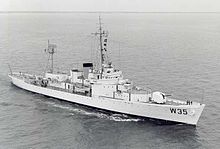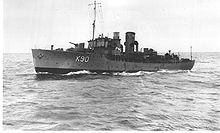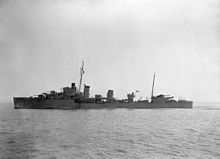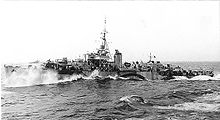- Mid-Ocean Escort Force
-
Mid-Ocean Escort Force (MOEF) referred to the organization of anti-submarine escorts for World War II trade convoys between Canada and the British Isles. The allocation of United States, British, and Canadian escorts to these convoys reflected preferences of the United States upon their declaration of war, and the organization persisted through the winter of 1942-43 despite withdrawal of United States ships from the escort groups. By the summer of 1943, United States Atlantic escorts were focused on the faster CU convoys and the UG convoys between Chesapeake Bay and the Mediterranean Sea; and only British and Canadian escorts remained on the HX, SC and ON convoys.
 HMCS Sackville, preserved at Halifax Harbour, is believed to be the only survivor of the MOEF Flower class corvettes
HMCS Sackville, preserved at Halifax Harbour, is believed to be the only survivor of the MOEF Flower class corvettes
Background
On the basis of experience during World War I, the Admiralty instituted trade convoys in United Kingdom coastal waters from September, 1939.[1] Anti-submarine escorts were allocated on the basis of perceived threat. Early German Type II submarines from bases in Germany were unable to operate effectively beyond European coastal waters. Following acquisition of bases in Norway and France, German Type IX submarines and German Type VII submarines refueled by German Type XIV submarines operated in the mid-Atlantic beyond the range of patrolling aircraft. Many anti-submarine escorts lacked the endurance to accompany convoys through the mid-Atlantic. HX 129 left Halifax on 27 May 1941 as the first convoy to receive escort for the entire trip.[2] Escorts based in Halifax Harbour handed HX 129 off to escorts based in Newfoundland who subsequently transferred HX 129 to escorts based in Iceland who in turn delivered HX 129 to escorts based in the Western Approaches.
American Escorts
In Newfoundland on 9 August 1941, President Franklin D. Roosevelt agreed to provide American destroyers for the Canada to Iceland portion of HX convoys and westbound ON convoys.[3] HX 150 sailed 16 September 1941 as the first convoy with American escort.[4] ON 18 sailed 24 September as the first westbound convoy with American escort.[5] The Royal Canadian Navy continued to escort the SC convoys and their slower ON counterparts.[6] Canadian escort groups were increased from a nominal strength of four ships to six -- typically one Canadian River class destroyer with five Flower class corvettes.[7]
The Gleaves class destroyer Kearny was torpedoed while escorting Convoy SC 48 on 17 October 1941.[8] Clemson class destroyer Reuben James was torpedoed and sunk on 31 October 1941 while escorting Convoy HX 156.[9] When the United States declared war, American escort groups typically contained five destroyers, although six USCG Treasury class cutters were included within the pool of ships rotating in and out of these escort groups.[10]
Long-Range Escort Organization
As the United States Navy struggled to find enough destroyers to meet escort needs for both the Pacific and the vulnerable Atlantic coastal shipping, the shorter great-circle route from Newfoundland to the British Isles was considered as a means of eliminating meeting point delays and reducing the number of destroyers required for escort of convoys between Canada and the United Kingdom. Initial proposals by the United States on 24 January 1942 produced an agreement in early February for a Mid-Ocean Escort Force organization of fourteen Escort Groups.[11] American-led Escort Groups were prefixed with the letter "A"; while "B" indicated British-led Escort Groups and "C" designated Canadian-led Escort Groups. Fifteen United States destroyers, fifteen Royal Navy destroyers and twelve Canadian destroyers were to provide the striking power of these escort groups while fifty-two British and forty-nine Canadian Flower class corvettes were to perform the patrolling role. Approximately one-third of the theoretical MOEF escort Group strength of three destroyers and seven corvettes was unavailable at any given time.[12] Half of the unavailable ships needed storm or battle damage repairs,[13] and the remainder were undergoing normal refit and training.
Each MOEF escort Group worked in a 33-day cycle allowing nine and one-half days with a westbound ON convoy, six days in St. John's, Newfoundland, nine and one-half days with an eastbound HX or SC convoy, and 8 days refit in Derry.[14] The shorter routing away from Iceland eliminated the need for most escorts to attempt maintenance in Iceland's poorly equipped Hvalfjörður anchorage; but the United States was required to maintain an additional force of five destroyers in Iceland to escort ships between trans-Atlantic convoys and United States military occupation bases. The Royal Navy continued to provide an eastern local escort force of Naval trawlers in the Western Approaches while Canada continued to provide a Western Local Escort Force (WLEF) of corvettes, minesweepers, and short-range destroyers between Halifax Harbour and Newfoundland.[15]
Initial MOEF Escort Group Composition
- Escort Group A-1: Benson class destroyer Benson and Clemson class destroyers Broome, MacLeish and McCormick with Flower class corvettes Alberni, Gleaves class destroyer Niblack and USCG Treasury class cutter Ingham with Flower class corvettes Mayflower, Rosthern, Gleaves class destroyer Gleaves with USCG Treasury class cutter Spencer and Flower class corvettes Bittersweet, Chilliwack, Shediac and Benson class destroyer Mayo and Clemson class destroyer Simpson with Flower class corvettes Gleaves class destroyer Bristol and Sims class destroyer Buck with Flower class corvettes G and H class destroyer Hurricane with Town class destroyer Rockingham, V and W class destroyer Flower class corvettes Anchusa,
Low-endurance Town class destroyer HMS Leamington was an early member of Escort Group B-2 later replaced by long-range V&W escorts HMS Vanessa and HMS Whitehall

- Escort Group A-1: Benson class destroyer Benson and Clemson class destroyers Broome, MacLeish and McCormick with Flower class corvettes Alberni, Gleaves class destroyer Niblack and USCG Treasury class cutter Ingham with Flower class corvettes Mayflower, Rosthern, Gleaves class destroyer Gleaves with USCG Treasury class cutter Spencer and Flower class corvettes Bittersweet, Chilliwack, Shediac and Benson class destroyer Mayo and Clemson class destroyer Simpson with Flower class corvettes Gleaves class destroyer Bristol and Sims class destroyer Buck with Flower class corvettes G and H class destroyer Hurricane with Town class destroyer Rockingham, V and W class destroyer Flower class corvettes Anchusa,
- Escort Group B-2: G and H class destroyer Hesperus with Town class destroyer Leamington, V and W class destroyer Veteran, and Flower class corvettes G and H class destroyer Harvester with Town class destroyer Georgetown, B class destroyer Bulldog, and Flower class corvettes Heartsease, Narcissus, G and H class destroyer Highlander with Town class destroyer Roxborough, V and W class destroyer Winchelsea, and Flower class corvettes G and H class destroyer Havelock with Town class destroyer Caldwell, V and W class destroyers Vanoc and Flower class corvettes
Flower class corvette HMS Dianthus served with Escort Groups A-3 and C-1

Mid-Ocean Escort Force
- Escort Group C-1: Canadian River class destroyer Assiniboine and Town class destroyer St. Croix with Flower class corvettes Buctouche, Chambly, Dianthus and Canadian River class destroyer St. Laurent with Town class destroyer Broadway and Flower class corvettes Canadian River class destroyers Saguenay and Skeena with Flower class corvettes Wetaskiwin, Sackville, Galt and Camrose[16]
- Escort Group C-4: Canadian River class destroyers Ottawa and Restigouche with Town class destroyer St. Francis and Flower class corvettes edit] Shortage of Destroyers
 USS Schenck was one of the low-endurance Wickes class destroyers providing escort to and from Iceland.
USS Schenck was one of the low-endurance Wickes class destroyers providing escort to and from Iceland.
Corvettes had adequate endurance for MOEF assignments, but destroyer fuel economy was poor at trade convoy speed. The escort group leaders were modern destroyers with adequate endurance; but, of the older destroyers allocated to trade convoy escort, only the Clemson subgroup of the Town class destroyers proved suitable for MOEF assignments.[17] Wickes class destroyers were useful for the Canadian WLEF and the American Iceland shuttle; but lacked endurance to stay with a trade convoy for the full distance covered by the MOEF Escort Groups. The Admiralty converted some V and W class destroyers to long range escorts by removing the forward boiler and using the space for additional fuel tanks.[18]
 The modern destroyer USS Sims was withdrawn from Iceland in late 1941 to escort USS Yorktown to the Pacific. Sims was sunk at the battle of the Coral Sea on 7 May 1942.
The modern destroyer USS Sims was withdrawn from Iceland in late 1941 to escort USS Yorktown to the Pacific. Sims was sunk at the battle of the Coral Sea on 7 May 1942.
Nineteen modern American destroyers left the Atlantic to escort battleships New Mexico, Mississippi, Idaho, and North Carolina and aircraft carriers Yorktown, Wasp, and Hornet to the Pacific.[19] Remaining American destroyers were diverted from MOEF assignments to troop convoys and in response to the U-boat's Second happy time off the American east coast.[20] Escort Groups A-1 and A-2 were disbanded when their modern American destroyer leaders were assigned elsewhere. Escort Groups A-4 and A-5 were redesignated B-6 and B-7, respectively, when the Royal Navy assigned E and F class destroyers Fame and Firedrake as leaders.[21] Escort Group B-5 was reassigned to Caribbean trade convoys in March 1942.[16] Beginning in April, the following eleven groups escorted HX convoys, SC convoys, and ON convoys through the winter of 1942-43:
Escort Group A-3
Convoy HX 185 was escorted without loss.[22] Gleaves class destroyer Gleaves left the escort group after convoy ON 92 lost seven ships.[23] USCG Treasury class cutters Spencer and Campbell assumed escort leader responsibility. Flower class corvettes Mayflower and Trillium replaced Flower class corvettes Chilliwack, Shediac and Flower class corvette Rosthern joined the group.[24] Convoy SC 100 lost 3 ships torpedoed by U-596, Flower class corvette Dianthus replaced Flower class corvettes Mayflower and Bittersweet.[24] Convoy ON 145 lost one ship torpedoed by U-518.[30] Flower class corvette Dauphin rotated into the group.[24] Convoys SC 111, ON 156 and HX 223 were escorted without loss.[31] Convoy ON 166 lost eleven ships.[28] Convoy SC 121 lost seven ships.[32] Convoy ON 175 was escorted without loss.[28] Convoy HX 233 lost one ship torpedoed by USCG Treasury class cutters were reassigned for conversion to amphibious force flagships.[34]
Escort Group B-1
Flower class corvettes long-range V&W escort edit] Escort Group B-2
Flower class corvettes long-range V&W escorts Convoy SC 118 lost eight ships.[32] Convoys ON 170, SC 123 and ONS 4 were escorted without loss.[37]
Escort Group B-3
Low-endurance destroyers Georgetown and Bulldog were replaced by the E and F class destroyer Escapade and the Polish destroyers Burza and Garland.[35] Flower class corvette Orchis replaced Heartsease and the four corvettes with Free French crews (Aconit, Thornycroft type leader Keppel was assigned as group leader replacement.[36] Convoy ON 174 was escorted without loss.[39] Convoy HX 232 lost three ships torpedoed by edit] Escort Group B-4
Flower class corvettes Abelia, Town class destroyer Beverley.[35] Convoys SC 82, ON 99, SC 87, ON 109, HX 199, ON 120, HX 204 and ON 130 were escorted without loss.[31] Convoy HX 209 lost one ship torpedoed by U-254.[40] Convoys ON 140, HX 214, ON 150, HX 220, ON 161 and ON 169 were escorted without loss.[26] Convoy HX 229 lost twelve ships.[28] Convoy ON 176 lost one ship and Beverly was torpedoed by edit] Escort Group B-6
The Norwegian-manned corvettes E and F class destroyer Fame were joined by the long-range V&W escort Town class destroyer Ramsey, and the Flower class corvettes Convoy SC 104 lost seven ships.[32] Convoy ON 144 lost 5 ships torpedoed by edit] Escort Group B-7
Flower class corvette E and F class destroyer Firedrake were joined by Town class destroyers Chesterfield and Ripley and by Flower class corvettes D class destroyer Duncan was assigned as group leader replacement;[46] and new River class frigate Tay joined the group.[47] Convoys SC 115, ON 164, SC 120 and ON 173 were escorted without loss.[48] Convoy HX 231 lost three ships torpedoed by Convoy ONS 5 lost eleven ships.[50]
Escort Group C-1
Corvette Buctouche was replaced by Flower class corvettes Battleford, Chilliwack, Convoy SC 94 lost ten ships.[32] Group leader Assiniboine and Flower class corvettes Dianthus, Flower class corvettes Eyebright, Napanee, Kenogami and Shediac.[51] Convoys ON 123, SC 99, ON 133, HX 211, ON 143 and SC 110 were escorted without loss.[31] Flower class corvettes Convoy ON 154 lost thirteen ships.[28] Convoy HX 222 lost one ship torpedoed by U-268.[53] Flower class corvette Chilliwack was replaced by new River class frigate edit] Escort Group C-2
Convoys SC 84, ON 103 and SC 89 were escorted without loss.[55] Destroyer Burnham replaced destroyer St. Laurent; and Flower class corvette Dauphin joined the group.[56] Convoy ON 113 lost three ships torpedoed by U-552, U-607 and U-132 while Town class destroyer St. Croix sank Flower class corvettes Pictou and Flower class corvettes Dauphin and Flower class corvette River class frigates edit] Escort Group C-3
Convoys ON 93, HX 191, ON 104 and SC 90 were escorted without loss.[31] Flower class corvette Camrose was replaced by corvette Agassiz.[59] Convoy ON 115 lost two ships torpedoed by U-552 and U-553 while Skeena and Flower class corvette Wetaskiwin sank Town class destroyer Burnham replaced Saguenay. Flower class corvettes Wetaskiwin, Sackville, Galt and Agassiz were replaced by corvettes Bittersweet, Eyebright, River class frigate edit] Escort Group C-4
Convoys ON 95, SC 85, ON 105, HX 197, ON 116 and SC 96 were escorted without loss.[31] Destroyer St. Francis was replaced by Town class destroyer St. Croix and Flower class corvettes Convoy ON 127 lost six ships;[28] and Ottawa was torpedoed by U-91.[63] Convoys SC 101 and ON 137 were escorted without loss.[55] Convoy SC 107 lost fifteen ships.[32] Destroyer St. Croix was replaced by Town class destroyer Churchill and Flower class corvette edit] Spring of 1943
Escort Group B-5 returned to MOEF with G and H class destroyer Havelock, Flower class corvettes River class frigate Swale replacing the old destroyers.[66] Convoy ON 168 was escorted without loss.[39] Convoy SC 122 lost 8 ships.[32] Convoy SC 126 was escorted without loss.[32]
River class frigates brought two significant advantages to MOEF. Their numbers allowed the older escorts time to refit with modern sensors like 10-centimeter radar and modern anti-submarine weapons like the Hedgehog projector. Destroyers replaced by new frigates were formed into mobile support groups able to move rapidly to convoys coming under attack.[67] Through 1943, new escort carriers became available to increase the surveillance capability of support groups.[68] As the winter weather cleared, new long-range B-24 Liberator patrol bombers extended surveillance into the mid-Atlantic.[69]
Notes
- ^ Hague 2000 p.23
- ^ van der Vat (1988) p.187
- ^ van der Vat (1988) p.205
- ^ Morison (1975) p.86
- ^ Morison (1975) p.90
- ^ van der Vat (1988) p.208
- ^ van der Vat (1988) p.209
- ^ Morison (1975) p.93
- ^ Morison (1975) p.94
- ^ Blair (1996) p.448
- ^ Blair (1996) pp.457-9
- ^ Milner (1985) p.109
- ^ Middlebrook (1975) p.40
- ^ Blair (1998) p.25
- ^ van der Vat (1988) p.262
- ^ a b c d e f g h i j k l m n o Rohwer&Hummelchen (1992) pp.124
- ^ Milner (1985) p.98
- ^ Lenton&Colledge (1968) p.79
- ^ Blair (1996) pp.750-1
- ^ Blair (1996) pp.460
- ^ Milner (1985) p.99
- ^ a b c Hague 2000 p.128
- ^ Milner 1985 pp.109&113-6
- ^ a b c d Milner (1985) pp.290-1
- ^ a b Rohwer&Hummelchen 1992 p.139
- ^ a b c d e f g Hague 2000 pp.128&158
- ^ a b Rohwer&Hummelchen 1992 p.157
- ^ a b c d e f g Hague 2000 p.158
- ^ Rohwer&Hummelchen 1992 p.162
- ^ a b Rohwer&Hummelchen 1992 p.167
- ^ a b c d e f g h i j k Hague 2000 pp.128,135&158
- ^ a b c d e f g Hague 2000 p.135
- ^ Rohwer&Hummelchen 1992 p.207
- ^ Silverstone 1968 p.373
- ^ a b c d e f g Rohwer&Hummelchen 1992 p.227
- ^ a b c d Rohwer&Hummelchen 1992 p.206
- ^ Hague 2000 pp.135,159&163
- ^ a b c d Rohwer&Hummelchen 1992 p.198
- ^ a b Hague 2000 p.159
- ^ Rohwer&Hummelchen 1992 p.166
- ^ Rohwer&Hummelchen 1992 p.205
- ^ a b Rohwer&Hummelchen 1992 p.177
- ^ Rohwer&Hummelchen 1992 p.180
- ^ Hague 2000 pp.128,135,158&163
- ^ a b Rohwer&Hummelchen 1992 p.182
- ^ Rohwer&Hummelchen 1992 p.212
- ^ Gannon 1989 pp.118-9
- ^ Hague 2000 pp.135&158-9
- ^ Rohwer&Hummelchen 1992 p.204
- ^ Hague 2000 p.163
- ^ a b Milner (1985) p.285
- ^ a b Milner (1985) p.287
- ^ a b Rohwer&Hummelchen 1992 p.188
- ^ Hague 2000 pp.135&163
- ^ a b c d e Hague 2000 pp.135&158
- ^ a b c d Milner (1985) pp.287-8
- ^ Rohwer&Hummelchen 1992 p.150
- ^ Rohwer&Hummelchen 1992 p.160
- ^ a b Milner (1985) pp.288-9
- ^ Rohwer&Hummelchen 1992 p.152
- ^ Hague 2000 pp.128,135&158-9
- ^ a b Milner (1985) pp.289-90
- ^ Rohwer&Hummelchen 1992 p.161
- ^ Rohwer&Hummelchen 1992 p.190
- ^ Hague 2000 pp.128&159
- ^ Middlebrook 1976 appendix
- ^ Gretton 1974 pp.173-4
- ^ Gannon 1989 p.365
- ^ Middlebrook 1976 p.53
References
- Blair, Clay (1996). Hitler's U-Boat War: The Hunters 1939-1942. Random House. ISBN 0-394-58839-8.
- Gannon, Michael (1989). Black May. Harper Collins. ISBN 0-06-017819-1.
- Gretton, Peter (1974). Crisis Convoy. Naval Institute Press. ISBN 0-87021-925-1.
- Hague, Arnold (2000). The Allied Convoy System 1939-1945. Naval Institute Press. ISBN 1-55750-019-3.
- Lenton, H.T. and Colledge J.J. (1968). British and Dominion Warships of World War II. Doubleday and Company.
- Middlebrook, Martin (1976). Convoy. William Morrow and Company.
- Milner, Marc (1985). North Atlantic Run. Naval Institute Press. ISBN 0-87021-450-0.
- Morison, Samuel Eliot (1975). History of United States Naval Operations in World War II, Volume I The Battle of the Atlantic 1939-1943. Little, Brown and Company.
- Rohwer, J. and Hummelchen, G. (1992). Chronology of the War at Sea 1939-1945. Naval Institute Press. ISBN 1-55750-105-X.
- Silverstone, Paul H. (1968). U.S. Warships of World War II. Doubleday and Company.
- van der Vat, Dan (1988). The Atlantic Campaign. Harper & Row. ISBN 0-06-015967-7.








